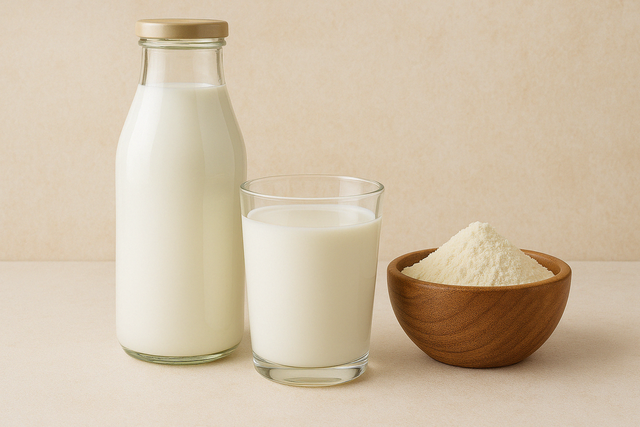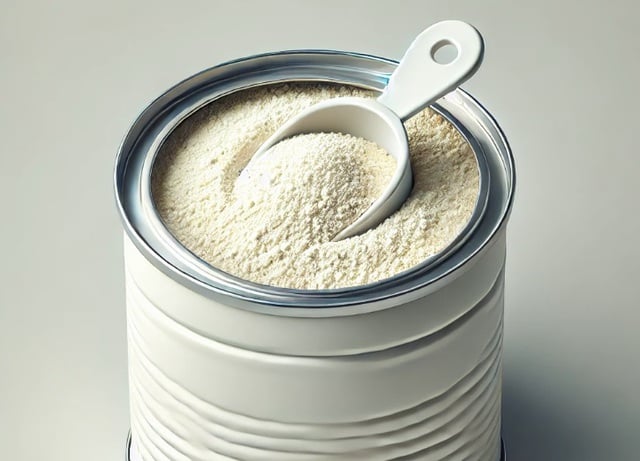The recent bust of a fake milk production line in Hanoi has caused a stir in public opinion. It is worrying that these fake products mainly target vulnerable groups such as children, pregnant and lactating women, the elderly, and people with underlying medical conditions such as kidney failure, diabetes, etc.
Counterfeit milk is milk produced with substandard processes, not ensuring nutritional value as declared on the label, including energy, vitamins and essential minerals. In addition, these products also have the potential to contain preservatives exceeding the permitted level or compounds harmful to the body.

Milk is a source of essential nutrients for the body.
Photo: AI
Nutritionist Le Thao Nguyen, Nam Sai Gon International General Hospital, said that using fake milk not only causes the body to lack essential nutrients, but can also lead to many serious health consequences.
Effects on liver and kidneys
In fact, many fake milks have been found to contain chemical additives and heavy metals such as lead, cadmium, or toxic colorants. When introduced into the body, these compounds increase the burden on the liver and kidneys – the two main organs responsible for filtering and detoxifying.
"If fake milk is used for a long time, the accumulated toxins can damage the liver and kidneys and increase the risk of serious diseases such as liver failure, kidney failure and cancer," said Dr. Nguyen.
Effects on the digestive system
Children and the elderly are particularly sensitive to poor quality ingredients in fake milk. Fake milk can cause digestive disorders with common symptoms such as abdominal pain, vomiting, diarrhea, etc.
Cardiovascular effects
Some types of fake milk have also been found to contain trans fat and excessive sodium levels, which are harmful to the cardiovascular system. Long-term use can increase bad cholesterol, increasing the risk of atherosclerosis, high blood pressure, and even stroke. This condition is especially dangerous for people with underlying medical conditions such as diabetes or kidney failure.

Fake milk is milk produced with substandard processes, not ensuring nutritional value as declared on the label.
ILLUSTRATION: AI
Impact on the immune system
The immune system - especially in young children and people with underlying diseases - depends heavily on micronutrients such as zinc, selenium, vitamins A, D, and essential fatty acids. However, fake milk often contains only very small amounts of these micronutrients, not enough to meet the body's needs. When the immune system is weakened, the risk of bacterial and viral infections from the outside environment increases. Children who use fake milk can easily get diseases such as pneumonia, otitis media, or flu. In adults, especially the elderly and people with underlying diseases, a weakened immune system can make the disease worse, increasing the risk of dangerous complications.
Risk of poisoning when drinking fake milk
Doctor Thao Nguyen said, acute poisoning is one of the serious consequences when young children use fake milk. Symptoms include severe vomiting, convulsions, high fever, and even coma. The cause of acute poisoning is often related to bacteria or toxins in fake milk, such as aflatoxin from mold, or toxic chemicals such as melamine. Melamine, if accumulated in the body, can cause kidney stones and acute kidney failure.
Chronic poisoning can occur when using fake milk for a long time, leading to the accumulation of toxic substances in the body. These fake milks often contain heavy metals such as lead, which seriously affect the nervous system. In children, lead can cause mental retardation, while in adults, it causes memory loss. In addition, long-term consumption of fake milk also increases the risk of cancer.
Some ways to help distinguish fake milk
Dr. Nguyen shares some basic ways for consumers to check and detect fake milk:
Check the barcode: Real milk has a barcode that matches the information about the manufacturer and country of origin (eg: Vietnam 893, USA 000-019 or 030 - 039). Meanwhile, many types of fake milk often have barcodes that cannot be checked for information.
Observe the color and texture: Real milk is light yellow or ivory white, has a smooth, spongy texture, and is not lumpy. Fake milk can be dark yellow, gray, or lumpy, and feels rough to the touch.
Smell and taste: Real milk has a light aroma, a sweet taste, and melts slowly in the mouth. Fake milk may have a strong, sour, or chemical smell.
However, according to Dr. Le Thao Nguyen, these 3 ways of distinguishing are for reference only.
"Currently, many types of milk are made so sophisticatedly that they are almost identical to real milk, including barcodes, labels, flavors and colors. Therefore, consumers should choose products with clear inspection documents, and should only buy at large supermarkets, reputable chain stores, or the manufacturer's official website," Dr. Nguyen recommends.
Source: https://thanhnien.vn/uong-sua-gia-anh-huong-den-noi-tang-he-mien-dich-tieu-hoa-the-nao-185250415145339388.htm





















































































Comment (0)